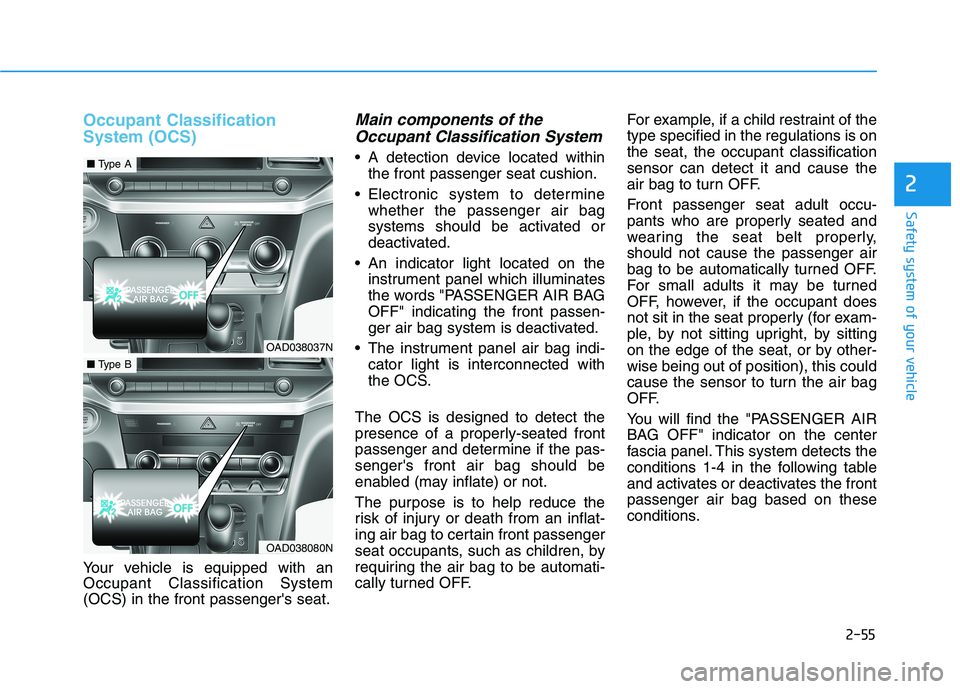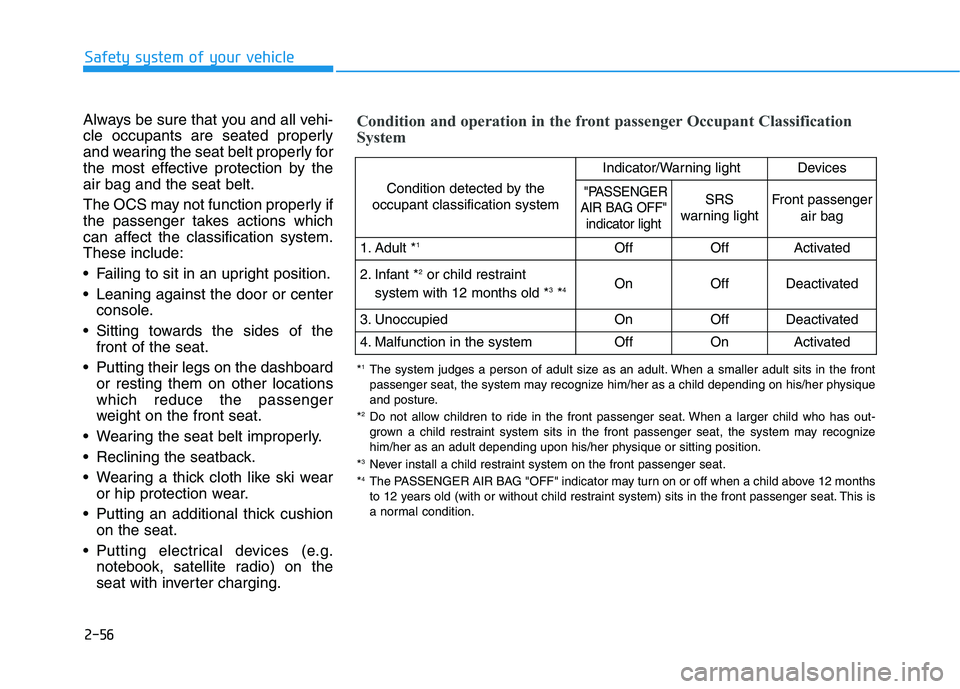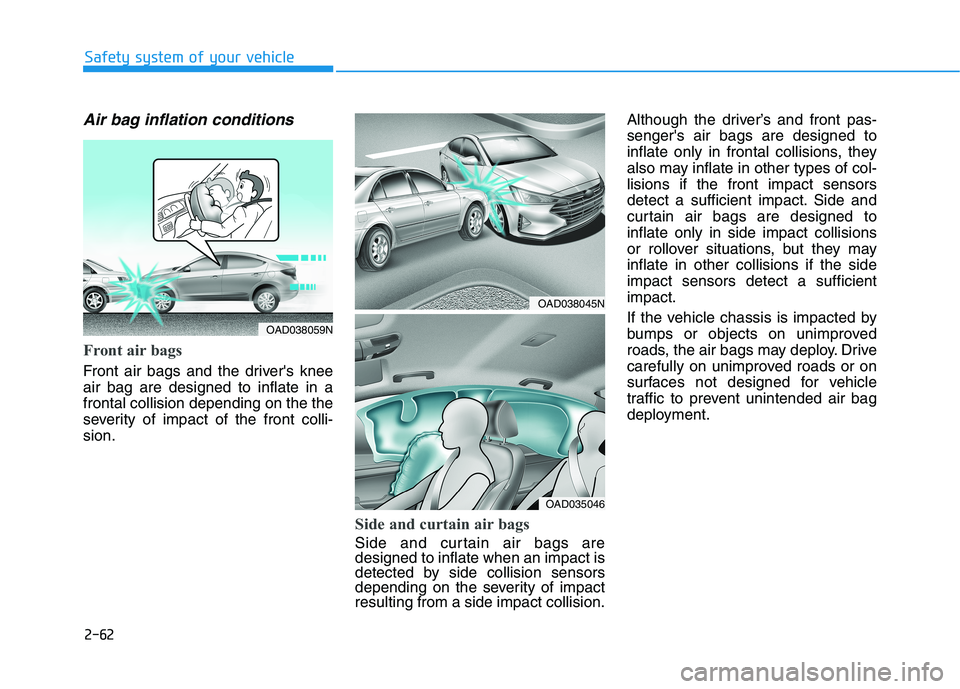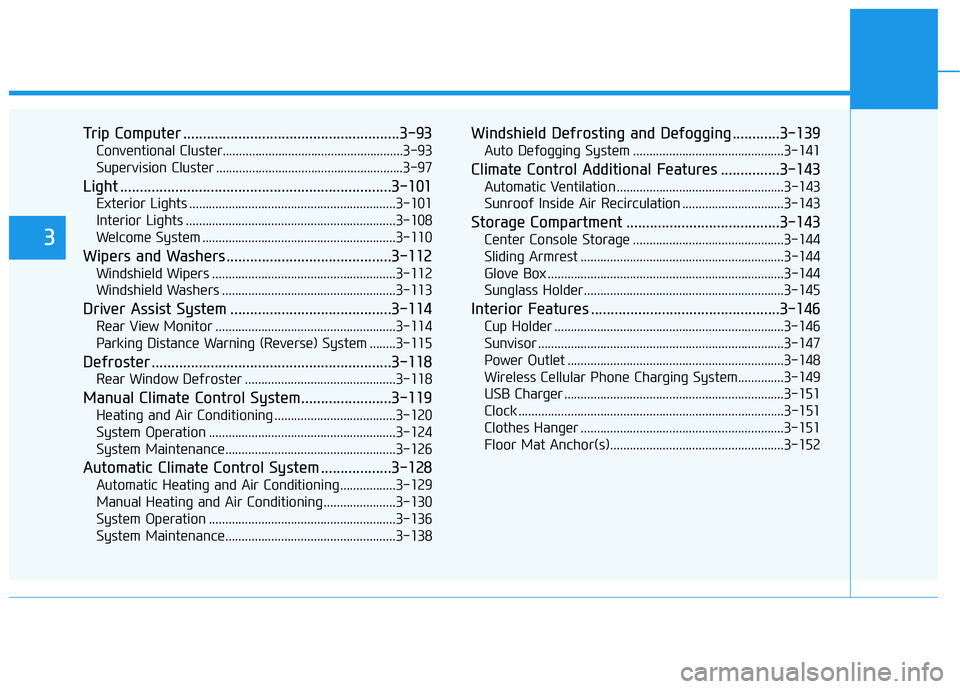2018 HYUNDAI ELANTRA SPORT air condition
[x] Cancel search: air conditionPage 10 of 534

F10
Introduction
This vehicle is equipped with an
event data recorder (EDR). Themain purpose of an EDR is to
record, in certain crash or near
crash-like situations, such as an
air bag deployment or hitting a
road obstacle, data that will assist
in understanding how a vehicle’s
systems performed. The EDR is
designed to record data related to
vehicle dynamics and safety sys-
tems for a short period of time,
typically 30 seconds or less. The
EDR in this vehicle is designed to
record such data as:
vehicle were operating;
passenger safety belts were
buckled/ fastened;
depressing the accelerator
and/or brake pedal; and,
ing. These data can help provide a bet-
ter understanding of the circum-
stances in which crashes and
injuries occur. NOTE: EDR data
are recorded by your vehicle onlyif a non-trivial crash situation
occurs; no data are recorded bythe EDR under normal driving
conditions and no personal data
(e.g., name, gender, age, and
crash location) are recorded.
However, other parties, such as
law enforcement, could combinethe EDR data with the type of per-
sonally identifying data routinely
acquired during a crash investiga-tion.
To read data recorded by an EDR,
special equipment is required, and
access to the vehicle or the EDR is
needed. In addition to the vehicle
manufacturer, other parties, such
as law enforcement, that have the
special equipment, can read the
information if they have access to
the vehicle or the EDR.
VV
EEHH IICC LLEE DD AA TTAA CC OO LLLLEE CCTT IIOO NN AA NN DD EE VV EENN TT DD AA TTAA RR EECCOO RRDD EERR SS
Page 19 of 534

Safety system of your vehicle
Important Safety Precautions ..............................2-2Always Wear Your Seat Belt ..........................................2-2
Restrain All Children .........................................................2-2
Air Bag Hazards .................................................................2-2
Driver Distraction ..............................................................2-2
Control Your Speed ...........................................................2-3
Keep Your Vehicle in Safe Condition ............................2-3
Seats ........................................................................2-4 Safety Precautions ...........................................................2-5
Front Seats .........................................................................2-6
Rear Seats.........................................................................2-12
Head Restraints ...............................................................2-15
Seat Warmers ...................................................................2-19
Seat Belts ..............................................................2-21 Seat Belt Safety Precautions .......................................2-21
Seat Belt Warning Light ................................................2-22
Seat Belt Restraint System...........................................2-24
Additional Seat Belt Safety Precautions ...................2-30
Care of Seat Belts...........................................................2-32 Child Restraint System (CRS) .............................2-33
Children Always in the Rear .........................................2-33
Selecting a Child Restraint System (CRS) .................2-34
Installing a Child Restraint System (CRS)..................2-36
Air Bag - Advanced Supplemental Restraint
System ...................................................................2-43 Where Are the Air Bags? ..............................................2-45
How Does the Air Bag System Operate?..................2-49
What to Expect After an Air Bag Inflates ................2-54
Occupant Classification System (OCS).......................2-55
Why Didn't My Air Bag Go Off in a Collision? ........2-60
SRS Care ............................................................................2-65
Additional Safety Precautions .....................................2-66
Air Bag Warning Labels .................................................2-67
This chapter provides you with important information about how to protect yourself and your passengers.
It explains how to properly use your seats and seat belts, and how your air bags work.
Additionally, this chapter explains how to properly restrain infants and children in your vehicle.
2
Page 58 of 534

2-40
Safety system of your vehicle
To install the tether anchor:
1. Route the child restraint tetherstrap over the child restraint seat-
back. Route the tether strap under
the head restraint and between
the head restraint posts, or route
the tether strap over the top of the
vehicle seatback. Make sure the
strap is not twisted.
2. Connect the tether strap hook to the tether anchor, then tighten the
tether strap according to the child
seat manufacturer’s instructions to
firmly secure the child restraint tothe seat. 3. Check that the child restraint is
securely attached to the seat by
pushing and pulling the seat for-
ward-and-back and side-to-side.
Securing a child restraint with
lap/shoulder belt
When not using the LATCH system,
all child restraints must be secured to
a vehicle rear seat with the lap partof a lap/shoulder belt.
Automatic locking mode
Since all passenger seat belts move
freely under normal conditions and
only lock under extreme or emer-
gency conditions (emergency locking
mode), you must manually pull the
seat belt all the way out to shift the
retractor to the "Automatic Locking"
mode to secure a child restraint.
The "Automatic Locking" mode will
help prevent the normal movement
of the child in the vehicle from caus-ing the seat belt to loosen and com-
promise the child restraint system. To
secure a child restraint system, use
the following procedure.
OAD035031
ALWAYS place a rear-facing
child restraint in the rear seat of
the vehicle.
Placing a rear-facing child
restraint in the front seat can
result in serious injury or death
if the child restraint is struck by
an inflating air bag.
WARNING
OLMB033044
Page 73 of 534

2-55
Safety system of your vehicle
2
Occupant Classification System (OCS)
Your vehicle is equipped with an Occupant Classification System(OCS) in the front passenger's seat.
Main components of theOccupant Classification System
A detection device located within the front passenger seat cushion.
Electronic system to determine whether the passenger air bag
systems should be activated or
deactivated.
An indicator light located on the instrument panel which illuminates
the words "PASSENGER AIR BAGOFF" indicating the front passen-
ger air bag system is deactivated.
The instrument panel air bag indi- cator light is interconnected with
the OCS.
The OCS is designed to detect the
presence of a properly-seated front
passenger and determine if the pas-senger's front air bag should be
enabled (may inflate) or not.
The purpose is to help reduce the
risk of injury or death from an inflat-
ing air bag to certain front passenger
seat occupants, such as children, by
requiring the air bag to be automati-
cally turned OFF. For example, if a child restraint of thetype specified in the regulations is onthe seat, the occupant classificationsensor can detect it and cause the
air bag to turn OFF.
Front passenger seat adult occu-
pants who are properly seated and
wearing the seat belt properly,should not cause the passenger air
bag to be automatically turned OFF.
For small adults it may be turned
OFF, however, if the occupant does
not sit in the seat properly (for exam-
ple, by not sitting upright, by sitting
on the edge of the seat, or by other-wise being out of position), this could
cause the sensor to turn the air bag
OFF.
You will find the "PASSENGER AIR
BAG OFF" indicator on the center
fascia panel. This system detects the
conditions 1-4 in the following table
and activates or deactivates the frontpassenger air bag based on these
conditions.
OAD038037N
■
Type A
OAD038080N
■Type B
Page 74 of 534

2-56
Safety system of your vehicle
Always be sure that you and all vehi-
cle occupants are seated properly
and wearing the seat belt properly for
the most effective protection by theair bag and the seat belt.
The OCS may not function properly if
the passenger takes actions which
can affect the classification system.These include:
Failing to sit in an upright position.
Leaning against the door or centerconsole.
Sitting towards the sides of the front of the seat.
Putting their legs on the dashboard or resting them on other locations which reduce the passenger
weight on the front seat.
Wearing the seat belt improperly.
Reclining the seatback.
Wearing a thick cloth like ski wear or hip protection wear.
Putting an additional thick cushion on the seat.
Putting electrical devices (e.g. notebook, satellite radio) on the
seat with inverter charging.Condition and operation in the front passenger Occupant Classification
System
Condition detected by the
occupant classification system
Indicator/Warning lightDevices
"PASSENGER
AIR BAG OFF"
indicator lightSRS
warning lightFront passenger
air bag
1. Adult * 1OffOffActivated
2. Infant * 2
or child restraint
system with 12 months old * 3
*4 OnOffDeactivated
3. Unoccupied OnOffDeactivated
4. Malfunction in the systemOffOnActivated
*
1
The system judges a person of adult size as an adult. When a smaller adult sits in the front
passenger seat, the system may recognize him/her as a child depending on his/her physique
and posture.
* 2
Do not allow children to ride in the front passenger seat. When a larger child who has out-
grown a child restraint system sits in the front passenger seat, the system may recognize
him/her as an adult depending upon his/her physique or sitting position.
* 3
Never install a child restraint system on the front passenger seat.
* 4
The PASSENGER AIR BAG "OFF" indicator may turn on or off when a child above 12 months
to 12 years old (with or without child restraint system) sits in the front passenger seat. This is
a normal condition.
Page 80 of 534

2-62
Safety system of your vehicle
Air bag inflation conditions
Front air bags
Front air bags and the driver's knee air bag are designed to inflate in afrontal collision depending on the the
severity of impact of the front colli-sion.
Side and curtain air bags
Side and curtain air bags are designed to inflate when an impact is
detected by side collision sensors
depending on the severity of impactresulting from a side impact collision.Although the driver’s and front pas- senger's air bags are designed to
inflate only in frontal collisions, they
also may inflate in other types of col-lisions if the front impact sensors
detect a sufficient impact. Side and
curtain air bags are designed toinflate only in side impact collisions
or rollover situations, but they mayinflate in other collisions if the sideimpact sensors detect a sufficientimpact.
If the vehicle chassis is impacted by
bumps or objects on unimproved
roads, the air bags may deploy. Drive
carefully on unimproved roads or on
surfaces not designed for vehicle
traffic to prevent unintended air bag
deployment.
OAD038059N
OAD038045N
OAD035046
Page 81 of 534

2-63
Safety system of your vehicle
2
Air bag non-inflation conditions
In certain low-speed collisions the air
bags may not deploy. The air bags
are designed not to deploy in such
cases because they may not provide
benefits beyond the protection of the
seat belts.Front air bags are not designed to
inflate in rear collisions, because
occupants are moved backward by
the force of the impact. In this case,
inflated air bags would not provide
any additional benefit.
Front air bags may not inflate in side
impact collisions, because occu-
pants move in the direction of the
collision, and thus in side impacts,
front air bag deployment would not
provide additional occupant protec-tion.
However, side and curtain air bags
may inflate depending on the severi-ty of impact.
OAD038049NOAD038048N
OAD038047N
Page 87 of 534

Trip Computer .......................................................3-93Conventional Cluster.......................................................3-93
Supervision Cluster .........................................................3-97
Light .....................................................................3-101 Exterior Lights ...............................................................3-101
Interior Lights ................................................................3-108
Welcome System ...........................................................3-110
Wipers and Washers..........................................3-112 Windshield Wipers ........................................................3-112
Windshield Washers .....................................................3-113
Driver Assist System .........................................3-114 Rear View Monitor .......................................................3-114
Parking Distance Warning (Reverse) System ........3-115
Defroster .............................................................3-118 Rear Window Defroster ..............................................3-118
Manual Climate Control System.......................3-119 Heating and Air Conditioning .....................................3-120
System Operation .........................................................3-124
System Maintenance....................................................3-126
Automatic Climate Control System ..................3-128 Automatic Heating and Air Conditioning.................3-129
Manual Heating and Air Conditioning......................3-130
System Operation .........................................................3-136
System Maintenance....................................................3-138 Windshield Defrosting and Defogging ............3-139
Auto Defogging System ..............................................3-141
Climate Control Additional Features ...............3-143 Automatic Ventilation ...................................................3-143
Sunroof Inside Air Recirculation ...............................3-143
Storage Compartment .......................................3-143 Center Console Storage ..............................................3-144
Sliding Armrest ..............................................................3-144
Glove Box ........................................................................3-144
Sunglass Holder.............................................................3-145
Interior Features ................................................3-146 Cup Holder ......................................................................3-146
Sunvisor ...........................................................................3-147
Power Outlet ..................................................................3-148
Wireless Cellular Phone Charging System..............3-149
USB Charger ...................................................................3-151
Clock .................................................................................3-151
Clothes Hanger ..............................................................3-151
Floor Mat Anchor(s).....................................................3-152
3